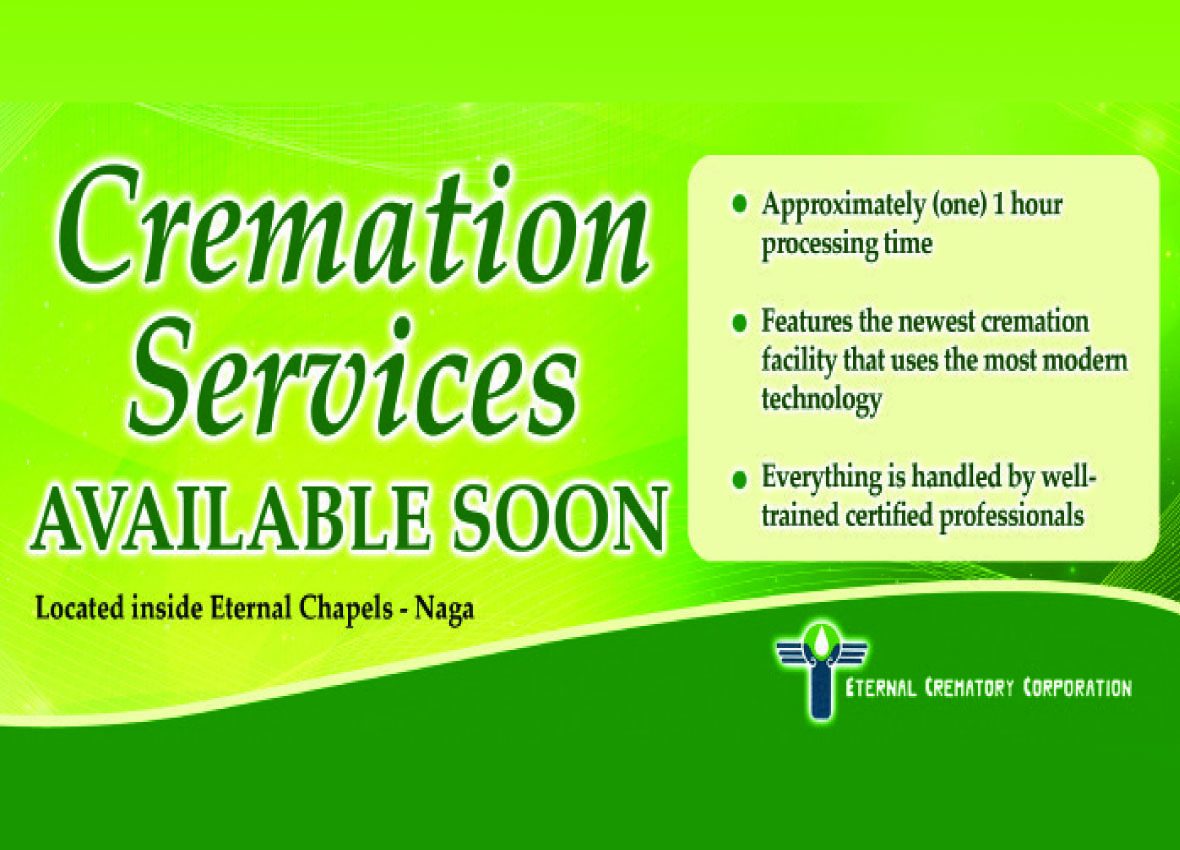FOR reasons of economy, cremation has become more and more popular and acceptable as a means of laying the departed to rest. The Catholic Church, however, has found it necessary to give guidance to Catholics around the world on the proper handling and disposition of cremated remains.
Responding to the need for more cremation facilities, Eternal Crematory Corporation was established in the 1990s. From the start, Eternal Crematory has been a staunch advocate of the proper conservation of ash remains called for by the Church, which is why in its four, soon to be five branches, it offers a dignified repository for the cremated remains of the deceased. The crypts at Eternal Crematory provide the bereaved family a perfect place to honor the memory and celebrate the life of their dearly depart-ed.aThe company’s first crematorium opened at Eternal Gardens in Baesa, Caloocan City, followed by three more crematories at the Eternal Gardens branches in the cities of Biñan in Laguna; Dagupan in Pangasinan, and Batangas. The residents of these cities wel-comed Eternal Crematory warmly, proving that Filipinos have become more open to the idea of cremation. Soon a new branch of Eternal Crematory will open, this time in Naga City in the Bicol Region. The new branch will be located inside the Eternal Chapels at Eternal Gardens Naga.
Guidance from the Vatican on the proper handling and disposition of cremated remains came in October 2016, through the doc-ument entitled Ad resurgendum cum Christo. The official document contains instructions approved by Pope Francis “regarding the burial of the deceased and the conservation of the ashes in the case of cremation.”
The document states some limitations that need to be observed in practicing cremation in a way consistent with the Christian faith. Literally meaning “to rise with Christ,” Ad resurgendum cum Christo provides the prescribed rules and guidelines for preserv-ing the cremated remains.
Section 5 of the document says: “When, for legitimate motives, cremation of the body has been chosen, the ashes of the faithful must be laid to rest in a sacred place, that is, in a cemetery or, in certain cases, in a church or an area which has been set aside for this purpose, and so dedicated by the competent ecclesial authority (Sec. 5, Ad resurgendum cum Christo).” Furthermore, the section explains that “the preservation of the ashes of the departed in a sacred place ensures that they are not excluded from the prayers and remembrance of their family or the Christian community. It prevents the faithful departed from being forgotten, or their remains from being shown a lack of respect, which eventuality is possible, most especially once the immediately subsequent generation has too passed away. Also, it prevents any unfitting or superstitious practices.”
This section highlights the importance of columbaria where the urns containing the cremains (cremated remains) of the deceased are put. Former prefect of the Congregation for the Doctrine of the Faith Cardinal Gerhard Muller explains that placing the cremains in a public place like a columbarium, marked by the person’s name, the same name with which the person was baptized and by which the person is called by God, “is an expression of belief in the ‘communion of saints,’ the unending unity in Christ of all the baptized, living and dead.”
The following section of Ad resurgendum cum Christo, Sec. 6, stats that “the conservation of the ashes of the departed in a do-mestic residence is not permitted. Only in grave and exceptional cases dependent on cultural conditions of a localized nature, may the Ordinary, in agreement with the Episcopal Conference or the Synod of Bishops of the Oriental Churches, concede permission for the conservation of the ashes of the departed in a domestic residence. Nonetheless, the ashes may not be divided among various family members and due respect must be maintained regarding the circumstances of such a conservation.” This prohibits the keeping of ash remains at home or dividing them among family members.
The scattering of ashes at sea or elsewhere, and its preservation in the form of jewelry, which at some point has become the trend, are also among the prohibited practices in Ad resurgendum cum Christo. Section 7 of the document states that “in order that every appearance of pantheism, naturalism or nihilism be avoided, it is not permitted to scatter the ashes of the faithful departed in the air, on land, at sea or in some other way, nor may they be preserved in mementos, pieces of jewelry or other objects.”
Being a predominantly Catholic country, it took a while before cremation became an accepted practice in the Philippines. But af-ter seeing the practical side of it, cremating the remains of deceased loved ones eventually gained popularity among Filipinos, prompting the emergence of crematories around the country.
As it continues to expand to reach more Filipinos, Eternal Crematory strengthens its commitment to help spread awareness on the guidelines set by the Catholic Church on the practice of cremation and proper conservation of cremated remains. It vows to continue to preserve our Catholic beliefs while providing excellent service to our countrymen.


Comments are closed.